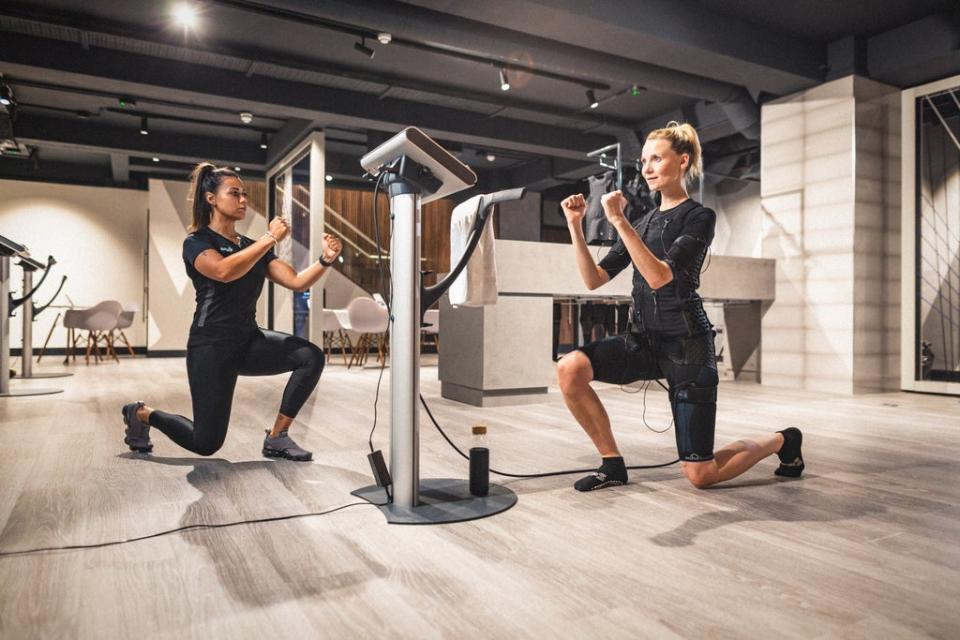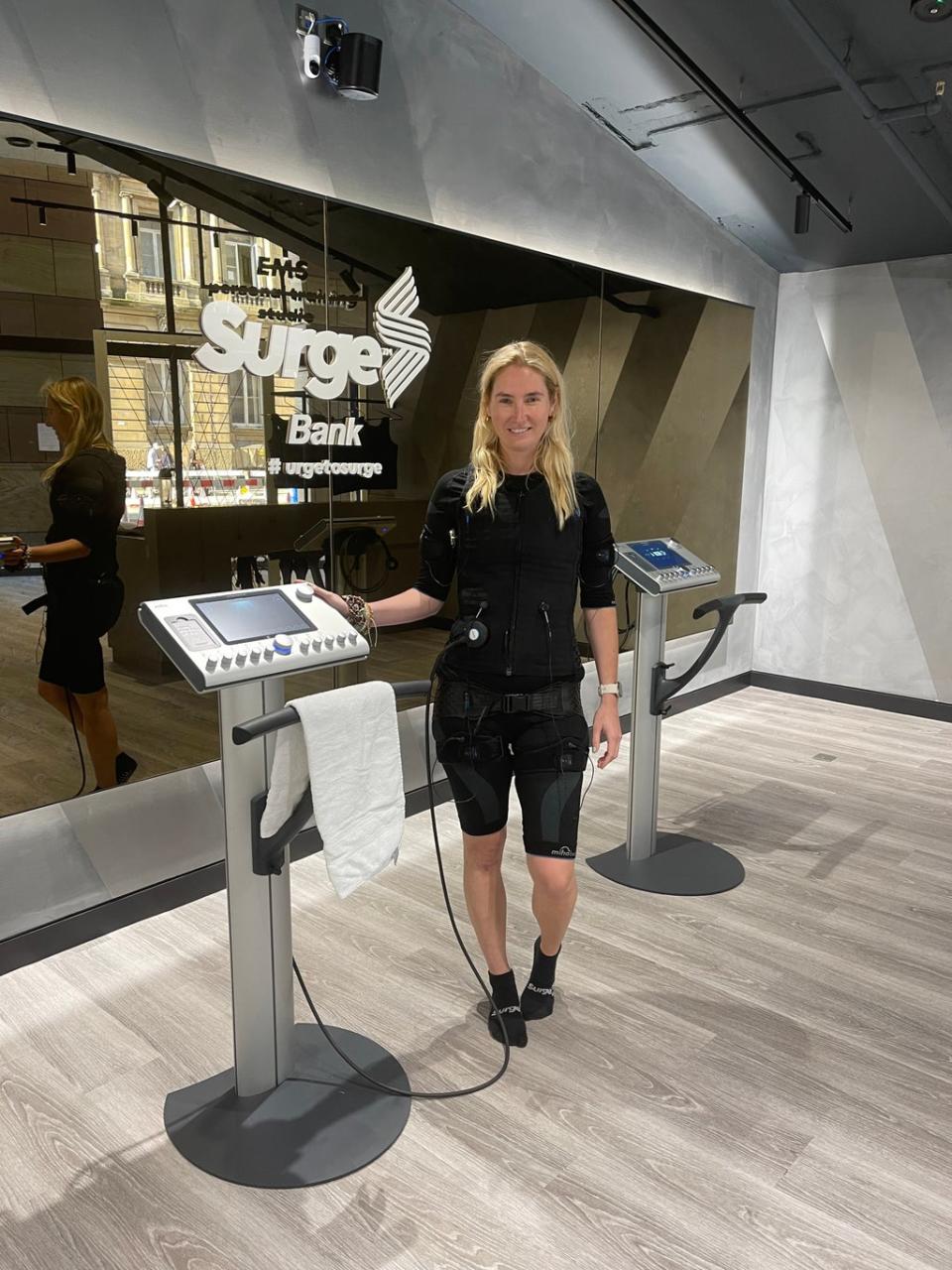EMS training is the hot new workout for autumn (and it only takes 20 minutes)

The winning formula for an endorphin-boosting workout? Something fun, challenging and efficient.
Enter EMS (electrical muscle stimulation) training, a full-body workout promising to deliver the equivalent of 90 minutes in the gym in just 20. It might sound too gimmicky to be true, but Rita Ora, Poppy Delevingne, Amelia Windsor and supermodel Alessandro Ambrosio are all hooked.
EMS has been around for a while but has been predominantly used by athletes to improve performance and aid recovery - the likes of Usain Bolt and Dina Asher-Smith are both big fans. Now, thanks to a wave of new boutique openings, it’s easier than ever to access in the capital.
E-Pulsive is where Delevingne and Windsor train, and it recently relocated to the shiny new Repose antigravity yoga space in High Street Kensington. Surge, meanwhile, has expanded with two new studios - at Fleet Street and Bank - which it now operates alongside its Hammersmith flagship.
How it works
EMS uses an electrical current to create controlled contractions deep into the muscles, which are similar to the messages sent by the central nervous system to muscles during a regular workout.
Consider it a strength workout. But there are no weights, which means you also avoid putting stress on joints, making it a lower-impact workout suitable for virtually anyone. Instead, you’re strapped into a vest (which is wet to aid conduction) with electrodes hooked up to each of your major muscle groups, on your arms, legs, glutes, abs and back.
The 20-minute session involves bodyweight exercises, like squats and holding the plank, while the electrodes stimulate muscle contractions every four seconds, for four seconds, followed by a four-second rest.

Put to the test
My first PT session is with Regina at E-Pulsive - classes are either private or in twos, so you can buddy up - who tells me I’ll soon be addicted to the benefits of EMS training. She says I should expect a tauter and tighter feeling physique after just a few sessions.
We adjust the current level for each muscle group from between 1 and 100. When it starts, it’s pretty uncomfortable and intense, like really strong vibrations going through you. Regina encourages me to withstand as much level as possible while still being able to perform each exercise with perfect form. The current intensifies the workout and makes it harder to work through the sequence, but as I make my way (slowly) through the exercises, I gradually feel my tolerance increasing. It’s the next day, when I can’t laugh or sneeze, that I realise those 20 minutes have really done some work on my abs.

Next, I head to Surge at Bank with lead trainer Holly Isaacs, who has trained Olympians with the vest. The beauty of the workout, she says, is that it eliminates the need for a gym bag. The studio provides everything, from what you wear under the vest to the socks, so it’s one less thing to remember in the morning - handy for time-poor city-slickers. It also activates eight major muscle groups simultaneously. “This means the muscle contractions all occur at the same time allowing us to achieve a full-body workout that is both highly effective in terms of muscle fibre activation and efficiency.
“Using traditional training methods, it’s almost impossible to design an exercise that activates the same number of muscles all in one go.” As your muscles acclimatise to the sensation, you can up your levels as you progress, just like you would with resistance training. So I go a little higher this time and one of the exercises, just punching the air, feels barely possible. While the workout can be totally low impact, the more explosive movements are more challenging. Isaacs wants to get me doing burpees in the vest eventually, which don’t sound fun.
It’ll be worth it, she assures me. “Our bodies are capable of activating more muscle fibres during an EMS training session in comparison to a conventional workout because you’re combining both a ‘free-will’ contraction alongside the ‘external stimulus’ sent from the EMS device.” If more muscle fibres are engaged in a given session and need to rebuild, this can prolong the post-workout effect known as muscle protein synthesis, which helps to improve strength and fat loss, she argues.
Verdict
Predictably, EMS classes don’t come cheap and average around the £50-£60 mark if you commit to a package, or roughly the same price as a personal training session. Isaacs says some of her clients only see her once a week and that’s all they do - the studio doesn’t recommend you do it more than once or twice a week to give your muscles time to recover.
Two days after my second session and the DOMS (delayed onset muscle soreness) have kicked in, but I can genuinely feel and see a difference in my limbs, everything feels more toned and tightened. If you’re short on time and looking for bang for your buck, like the celebrities who love it, EMS is a no-brainer.
E-Pulsive offers a £20 trial session or £60 per session for 13 sessions; High Street Kensington; e-pulsive.co.uk
Surge offer a free trial or it’s £49 per session with a three month membership ( 13 session); Hammersmith, Fleet Street, Bank; surge.co.uk


